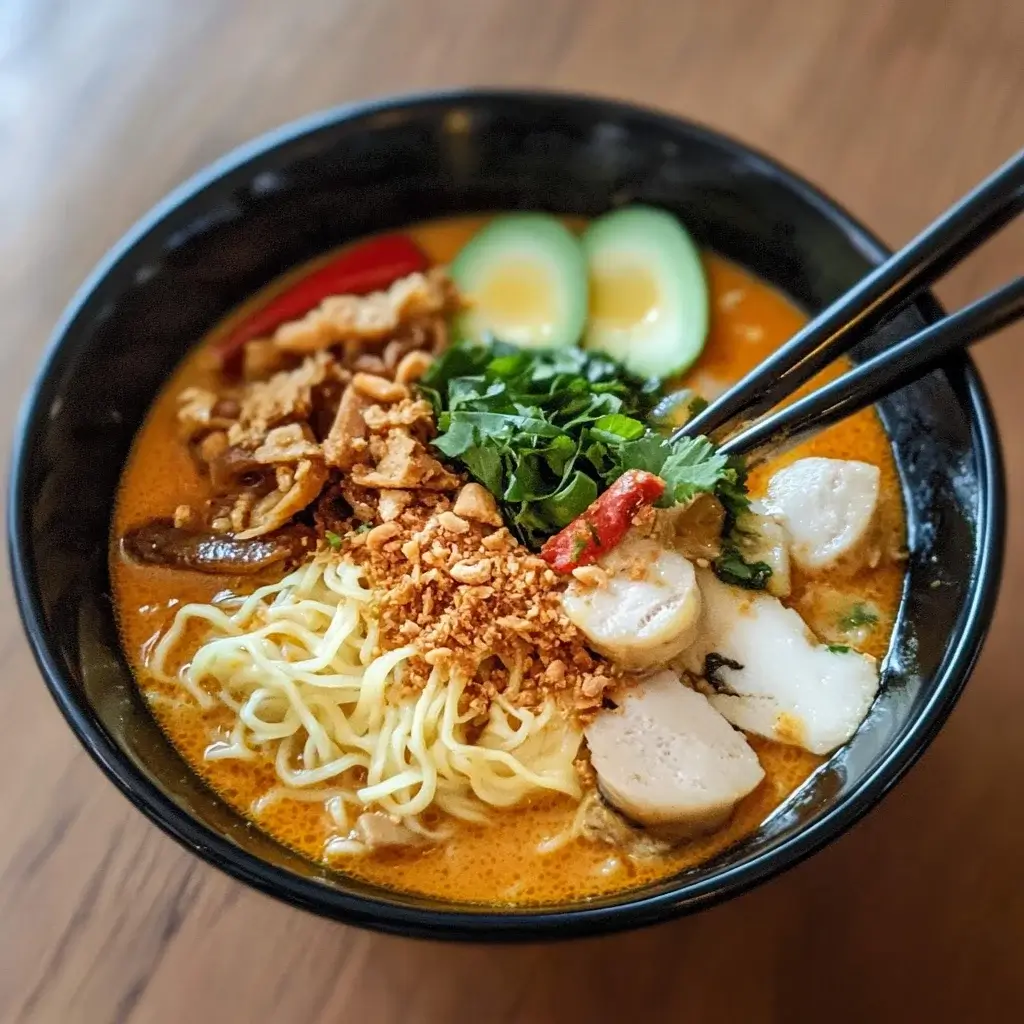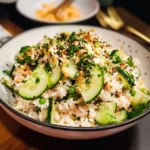This Laksa recipe has become a treasured staple in our home, a vibrant, aromatic hug in a bowl that instantly transports us to the bustling street food scenes of Southeast Asia. The first time I successfully recreated the complex, multi-layered broth from scratch, my kitchen was filled with the most intoxicating aromas of lemongrass, galangal, chilies, and coconut milk. My family, initially intrigued by the exotic scent, were absolutely blown away by the explosion of flavors – the creamy, spicy, tangy, and savory notes all dancing together in perfect harmony. It’s the kind of dish that’s a little bit of a project, yes, but the process of building the rempah (spice paste) and watching the laksa come together is incredibly satisfying. Now, it’s our go-to for when we crave something truly special, a dish that warms the soul and excites the palate in equal measure.
Why This Laksa Recipe Will Ignite Your Culinary Passion
Laksa, a beloved noodle soup from Peranakan culture with deep roots in Malaysia, Singapore, Indonesia, and Thailand, is more than just a meal; it’s an experience. It’s a vibrant tapestry of flavors and textures that captivates and comforts.
- Explosion of Complex Flavors: At its heart, laksa is all about the broth – a rich, aromatic, and often spicy concoction. It masterfully balances creamy coconut milk with a pungent spice paste (rempah) typically featuring lemongrass, galangal, turmeric, chilies, shallots, garlic, and dried shrimp or shrimp paste (belacan). The result is a soup that is simultaneously savory, spicy, tangy, slightly sweet, and deeply umami.
- Hearty and Satisfying: A generous bowl of laksa, brimming with noodles, protein (like chicken, shrimp, or tofu), and various toppings, is incredibly filling and satisfying. It’s a complete meal in itself.
- Aromatic Sensation: The moment you start preparing the rempah and simmering the broth, your kitchen will be filled with an intoxicating perfume that promises a delicious adventure.
- Customizable to Your Liking: While there are many regional variations of laksa (like Curry Laksa, Assam Laksa, Sarawak Laksa), this recipe focuses on a creamy, coconut-based version (often referred to as Curry Laksa or Laksa Lemak). Even within this style, you can adjust the spice level, choice of protein, noodles, and toppings to suit your preferences.
- A Culinary Adventure: Making laksa from scratch, especially the spice paste, is a rewarding culinary journey. It allows you to connect with traditional cooking methods and understand the art of flavor building.
- Impressive and Festive: A beautifully assembled bowl of laksa, with its vibrant colors and array of toppings, is visually stunning and perfect for impressing guests or celebrating special occasions.
This isn’t just another noodle soup recipe; it’s an invitation to explore a world of bold, unforgettable flavors that will leave a lasting impression.
Ingredients for an Authentic and Aromatic Laksa
Crafting a truly memorable Laksa requires a thoughtful selection of fresh aromatics, spices, and quality core components. While some ingredients may require a trip to an Asian market, they are essential for authentic flavor.
For the Laksa Paste (Rempah):
- Dried Red Chilies: 8-12 (adjust to your spice preference), soaked in hot water for 20-30 minutes, then deseeded and roughly chopped
- Shallots: 4-5 large (or 8-10 small), peeled and roughly chopped
- Garlic: 5-6 cloves, peeled and roughly chopped
- Galangal (Blue Ginger): 2-inch piece, peeled and thinly sliced (essential for authentic flavor; use ginger if unavailable, but the taste will differ)
- Lemongrass: 2-3 stalks, tough outer layers removed, white and pale green parts thinly sliced
- Fresh Turmeric: 1-inch piece, peeled and sliced (or 1 teaspoon ground turmeric)
- Candlenuts (Buah Keras): 3-4 (or macadamia nuts/cashews as a substitute), lightly toasted if desired
- Dried Shrimp (Udang Kering): 2 tablespoons, soaked in hot water for 15-20 minutes, then drained (optional, but adds significant umami)
- Shrimp Paste (Belacan/Terasi): 1-2 teaspoons, toasted (wrap in foil and toast in a dry pan until fragrant – this is pungent but crucial for depth)
- Coriander Seeds: 1 teaspoon, toasted
- Cumin Seeds: ½ teaspoon, toasted (optional)
- Vegetable Oil: 2-3 tablespoons (for blending and frying the paste)
For the Laksa Broth & Assembly:
- Chicken or Vegetable Broth/Stock: 4-5 cups
- Full-Fat Coconut Milk: 2 cans (each 13.5 oz / 400ml)
- Laksa Leaves (Daun Kesum / Vietnamese Mint / Rau Răm): A generous handful, roughly chopped (essential for signature laksa aroma)
- Tofu Puffs (Tau Pok): 8-10 pieces, halved or quartered (they soak up the broth beautifully)
- Fish Sauce: 1-2 tablespoons (or to taste)
- Sugar (Palm Sugar or Granulated): 1-2 teaspoons (or to taste, to balance flavors)
- Lime Juice: Freshly squeezed, from 1-2 limes (to taste, for brightness at the end)
- Salt: To taste
For Serving (Noodles & Toppings):
- Noodles: 1 pound (450g) – traditionally a mix of:
- Thick Rice Vermicelli (Laksa Noodles / Lai Fun): Or other thick, round rice noodles.
- Yellow Egg Noodles (Hokkien Noodles):
- (You can use one type or a combination, or even spaghetti/linguine in a pinch)
- Protein:
- Cooked Chicken Breast or Thigh, shredded or sliced
- Large Shrimp/Prawns, peeled, deveined, and cooked
- Fish Balls or Fish Cakes, sliced
- Hard-Boiled Eggs, halved
- Fried Tofu Slices (in addition to tofu puffs)
- Vegetables & Garnishes:
- Bean Sprouts (Mung Bean Sprouts), blanched or fresh
- Cucumber, julienned
- Extra Laksa Leaves, finely sliced
- Red Chili, thinly sliced
- Fried Shallots (Bawang Goreng)
- Sambal Oelek or Sambal Belacan (for extra spice on the side)
- Lime Wedges
Step-by-Step Instructions to Laksa Heaven
Making laksa is a multi-step process, but each stage contributes to the final masterpiece. Read through all instructions before starting.
1. Prepare the Laksa Paste (Rempah):
- Prep Aromatics: Ensure all rempah ingredients (soaked dried chilies, shallots, garlic, galangal, lemongrass, turmeric, candlenuts, soaked dried shrimp, toasted shrimp paste, toasted coriander/cumin seeds) are prepped as described in the ingredients list.
- Blend the Paste: Combine all the prepared rempah ingredients in a food processor or a powerful blender. Add 2-3 tablespoons of vegetable oil (or a little of the chili soaking water) to help the blades move and create a smooth paste. Blend until as smooth as possible, scraping down the sides as needed. This might take a few minutes.
2. Cook the Laksa Paste:
- Heat 1-2 tablespoons of vegetable oil (if your paste is already oily, you might need less) in a large, heavy-bottomed pot or Dutch oven over medium heat.
- Add the blended laksa paste to the pot. Cook, stirring frequently, for 10-15 minutes. This step is crucial and known as “tumis” or “pecah minyak” (breaking the oil). The paste will darken slightly, become very fragrant, and the oil will start to separate from the paste. This cooks out the raw taste of the aromatics and deepens the flavor. Be patient and don’t let it burn (adjust heat if necessary).
3. Build the Laksa Broth:
- Once the rempah is well cooked and fragrant, pour in the chicken or vegetable broth. Stir well to combine with the paste, scraping up any bits from the bottom of the pot.
- Bring the broth to a gentle simmer.
- Add the full-fat coconut milk and the roughly chopped laksa leaves. Stir gently to combine.
- Add the tofu puffs to the broth (they will absorb the flavors as it simmers).
- Let the laksa broth simmer gently (do not let it come to a rolling boil, as this can cause the coconut milk to curdle) for at least 20-30 minutes, or longer for even deeper flavor, stirring occasionally. The longer it simmers, the more the flavors will meld.
4. Season and Balance the Broth:
- After simmering, season the broth with fish sauce, sugar (palm sugar is traditional), and salt. Start with smaller amounts and taste frequently, adjusting to achieve a perfect balance of savory, spicy, slightly sweet, and umami. Remember that the noodles and toppings are unseasoned, so the broth should be well-flavored.
- Just before serving, stir in the fresh lime juice for brightness. Taste one last time and make any final adjustments.
5. Prepare Noodles and Toppings:
- Cook Noodles: Cook your chosen noodles according to package directions. If using a mix, cook them separately. Drain well.
- Prepare Protein: Ensure your chicken is cooked and shredded/sliced, shrimp are cooked, fish balls/cakes are ready, and eggs are hard-boiled and halved.
- Prep Garnishes: Blanch bean sprouts briefly if desired (or serve fresh), julienne cucumber, slice extra laksa leaves and chili, and have fried shallots and sambal ready.
6. Assemble Your Bowl of Laksa:
- Place a generous portion of cooked noodles (or a mix) into each large serving bowl.
- Arrange your chosen protein (chicken, shrimp, fish balls) and some blanched bean sprouts over the noodles.
- Ladle the hot, fragrant laksa broth generously over the noodles and toppings, ensuring you include some tofu puffs.
- Garnish lavishly with a hard-boiled egg half, julienned cucumber, sliced fresh laksa leaves, sliced red chili, and a sprinkle of fried shallots.
- Serve immediately with extra lime wedges and sambal on the side for those who want an extra kick.
Nutrition Facts (Approximate)
Please note that these nutritional values are highly variable and depend on the specific ingredients used (especially the amount of coconut milk, types of protein, and portion size). This is a rich and hearty dish.
- Servings: This recipe typically yields 4-6 generous servings.
- Calories per serving: Approximately 700-1000+ calories.
Laksa is rich in fats (primarily from coconut milk and nuts in the paste), carbohydrates (from noodles), and protein (depending on additions). It also provides various vitamins and minerals from the array of spices, herbs, and vegetables.
Preparation and Cook Time
Laksa is a labor of love, but the results are well worth the effort.
- Preparation Time: 45-60 minutes (includes soaking chilies/shrimp, chopping aromatics for rempah, prepping toppings).
- Cook Time:
- Rempah Cooking: 10-15 minutes.
- Broth Simmering: 30-45 minutes (or longer).
- Noodle/Topping Prep: Concurrent or 15-20 minutes.
- Total Time: Approximately 1.5 – 2.5 hours.
This is often a weekend project or a dish for special occasions.
How to Serve Your Masterpiece Laksa
Serving laksa is an art in itself, creating a visually appealing and flavor-packed bowl.
- The Foundation:
- Start with a generous nest of cooked noodles at the bottom of a large, deep bowl.
- Layering the Goodness:
- Arrange your cooked proteins (shrimp, chicken, fish cakes) and blanched bean sprouts attractively over the noodles.
- The Soul of the Dish:
- Ladle plenty of the hot, fragrant laksa broth over everything, ensuring you get some of those delicious tofu puffs.
- The Crown of Garnishes: This is where you add color, texture, and fresh flavors:
- A halved hard-boiled egg.
- A pile of julienned cucumber for coolness and crunch.
- A sprinkle of finely sliced fresh laksa leaves (Daun Kesum) for that signature aroma.
- Thinly sliced red chili for an extra pop of color and heat.
- A generous scattering of crispy fried shallots (Bawang Goreng) for savory crunch.
- On the Side:
- Always serve with lime wedges for diners to squeeze in fresh tartness.
- A small dish of sambal oelek or sambal belacan for those who crave even more intense spice.
Each spoonful should offer a delightful mix of noodles, broth, protein, and the fresh crunch of garnishes.
Additional Tips for Laksa Nirvana
Elevate your laksa game from delicious to truly divine with these five essential insights:
- Invest Time in the Rempah (Spice Paste): The heart and soul of any great laksa is its rempah.
- Freshness Matters: Use the freshest aromatics you can find (galangal, lemongrass, turmeric, shallots, garlic).
- Toast Your Spices: Toasting whole spices like coriander and cumin (if using) before grinding, and toasting the belacan (shrimp paste), awakens their aromas and deepens their flavors significantly.
- Patience in Cooking (“Pecah Minyak”): Don’t rush the process of frying the blended rempah. Cook it over medium-low heat, stirring frequently, until it darkens, becomes intensely fragrant, and the oil visibly separates (“pecah minyak”). This step cooks out rawness and melds the flavors beautifully. This can take 10-15 minutes or more.
- Achieve Broth Balance: The laksa broth should be a harmonious symphony of flavors.
- Coconut Milk Quality: Use good quality, full-fat coconut milk for the best creaminess and richness.
- Gentle Simmer: Once coconut milk is added, maintain a gentle simmer. A rolling boil can cause the coconut milk to curdle or separate.
- Taste and Adjust Repeatedly: After the initial seasoning, taste the broth frequently. Does it need more fish sauce for saltiness/umami? More sugar (palm sugar is best) for balance? More lime juice for brightness? This final balancing act is crucial.
- Don’t Skimp on Laksa Leaves (Daun Kesum): This herb, also known as Vietnamese Mint or Rau Răm, has a distinctive peppery, slightly citrusy flavor that is absolutely essential for an authentic laksa aroma and taste. It’s worth seeking out at Asian markets. Add a generous amount to the broth and use it fresh as a garnish.
- The Magic of Tofu Puffs (Tau Pok): These airy, deep-fried tofu cubes are like little sponges that soak up the rich laksa broth beautifully, providing delightful bursts of flavor with every bite. Don’t omit them if you can find them!
- Layer Your Toppings Thoughtfully: Laksa is as much about the toppings as it is about the broth and noodles. A good variety of textures and fresh elements elevates the dish. Blanch bean sprouts briefly to retain crunch but remove rawness. Julienne cucumber finely. Ensure proteins are cooked perfectly. The final flourish of fresh herbs and fried shallots makes a huge difference.
Frequently Asked Questions (FAQ)
Here are answers to some common questions about making Laksa:
- Q: What if I can’t find some specific ingredients like galangal or laksa leaves?
A: While these ingredients are key for authentic flavor:- Galangal: If you absolutely cannot find fresh or frozen galangal, you can use fresh ginger as a substitute, but be aware the flavor profile will be different (galangal is more citrusy and piney, ginger is spicier and warmer). Use slightly less ginger than the amount of galangal called for.
- Laksa Leaves (Daun Kesum): This is a tough one to substitute as its flavor is very unique. Some suggest a mix of mint and cilantro, but it won’t be the same. If unavailable, focus on other fresh herbs like cilantro and Thai basil for garnish, though the core laksa aroma will be less distinct.
- Candlenuts: Macadamia nuts or raw cashews are good substitutes.
- Shrimp Paste (Belacan): If you can’t find it or are averse to its strong smell (though it mellows significantly when cooked), you can omit it, but the broth will lack a certain depth of umami. You could try adding a little extra fish sauce or a dash of miso paste (not traditional, but adds umami).
- Q: How can I adjust the spice level of the laksa?
A: The spice level primarily comes from the dried red chilies and fresh chilies in the rempah and garnish.- To Reduce Spice: Use fewer dried chilies in the rempah, and make sure to deseed them thoroughly. Omit or use milder fresh chilies for garnish. You can also add a little more coconut milk or a touch more sugar to the broth to balance the heat.
- To Increase Spice: Use more dried chilies (or spicier varieties like bird’s eye chilies) in the rempah. Add more fresh chili slices as a garnish or serve with a potent sambal on the side.
- Q: Can I make Laksa vegetarian or vegan?
A: Yes, with some modifications:- Rempah: Omit the dried shrimp and shrimp paste (belacan). To compensate for the lost umami, you could add a tablespoon or two of miso paste (white or yellow) or some rehydrated and finely chopped dried shiitake mushrooms to the rempah.
- Broth: Use vegetable broth instead of chicken broth.
- Seasoning: Use a vegan fish sauce alternative or light soy sauce/tamari instead of traditional fish sauce.
- Protein: Use fried tofu, more tofu puffs, seitan, or an array of mushrooms (like oyster or king oyster) and vegetables. Omit hard-boiled eggs or use a vegan egg alternative.
- Q: Can I make the Laksa paste (rempah) ahead of time?
A: Absolutely! The rempah can be made 2-3 days in advance and stored in an airtight container in the refrigerator. You can even cook the rempah (“tumis” stage) and then store it. This actually helps the flavors meld further. You can also freeze the uncooked or cooked rempah for longer storage (up to 2-3 months). - Q: How do I store and reheat leftover Laksa?
A: It’s best to store the laksa broth separately from the noodles and toppings, if possible, as noodles can become soggy. Store the broth in an airtight container in the refrigerator for up to 3-4 days. Store cooked noodles and toppings separately.- To Reheat: Gently reheat the broth on the stovetop until hot (avoid a rolling boil if it contains coconut milk). Cook fresh noodles or briefly refresh leftover noodles in hot water. Assemble the bowl with fresh toppings as you would initially.
Embarking on the journey of making homemade Laksa is a deeply rewarding culinary experience. The symphony of aromas, the richness of the broth, and the explosion of flavors in every spoonful make it an unforgettable dish that’s well worth the effort. Enjoy the process and the delicious results!
Print
Authentic Laksa recipe
Ingredients
For the Laksa Paste (Rempah):
-
- Dried Red Chilies: 8-12 (adjust to your spice preference), soaked in hot water for 20-30 minutes, then deseeded and roughly chopped
-
- Shallots: 4-5 large (or 8-10 small), peeled and roughly chopped
-
- Garlic: 5-6 cloves, peeled and roughly chopped
-
- Galangal (Blue Ginger): 2-inch piece, peeled and thinly sliced (essential for authentic flavor; use ginger if unavailable, but the taste will differ)
-
- Lemongrass: 2-3 stalks, tough outer layers removed, white and pale green parts thinly sliced
-
- Fresh Turmeric: 1-inch piece, peeled and sliced (or 1 teaspoon ground turmeric)
-
- Candlenuts (Buah Keras): 3-4 (or macadamia nuts/cashews as a substitute), lightly toasted if desired
-
- Dried Shrimp (Udang Kering): 2 tablespoons, soaked in hot water for 15-20 minutes, then drained (optional, but adds significant umami)
-
- Shrimp Paste (Belacan/Terasi): 1-2 teaspoons, toasted (wrap in foil and toast in a dry pan until fragrant – this is pungent but crucial for depth)
-
- Coriander Seeds: 1 teaspoon, toasted
-
- Cumin Seeds: ½ teaspoon, toasted (optional)
-
- Vegetable Oil: 2-3 tablespoons (for blending and frying the paste)
For the Laksa Broth & Assembly:
-
- Chicken or Vegetable Broth/Stock: 4-5 cups
-
- Full-Fat Coconut Milk: 2 cans (each 13.5 oz / 400ml)
-
- Laksa Leaves (Daun Kesum / Vietnamese Mint / Rau Răm): A generous handful, roughly chopped (essential for signature laksa aroma)
-
- Tofu Puffs (Tau Pok): 8-10 pieces, halved or quartered (they soak up the broth beautifully)
-
- Fish Sauce: 1-2 tablespoons (or to taste)
-
- Sugar (Palm Sugar or Granulated): 1-2 teaspoons (or to taste, to balance flavors)
-
- Lime Juice: Freshly squeezed, from 1-2 limes (to taste, for brightness at the end)
-
- Salt: To taste
For Serving (Noodles & Toppings):
-
- Noodles: 1 pound (450g) – traditionally a mix of:
-
- Thick Rice Vermicelli (Laksa Noodles / Lai Fun): Or other thick, round rice noodles.
-
- Yellow Egg Noodles (Hokkien Noodles):
-
- (You can use one type or a combination, or even spaghetti/linguine in a pinch)
-
- Noodles: 1 pound (450g) – traditionally a mix of:
-
- Protein:
-
- Cooked Chicken Breast or Thigh, shredded or sliced
-
- Large Shrimp/Prawns, peeled, deveined, and cooked
-
- Fish Balls or Fish Cakes, sliced
-
- Hard-Boiled Eggs, halved
-
- Fried Tofu Slices (in addition to tofu puffs)
-
- Protein:
-
- Vegetables & Garnishes:
-
- Bean Sprouts (Mung Bean Sprouts), blanched or fresh
-
- Cucumber, julienned
-
- Extra Laksa Leaves, finely sliced
-
- Red Chili, thinly sliced
-
- Fried Shallots (Bawang Goreng)
-
- Sambal Oelek or Sambal Belacan (for extra spice on the side)
-
- Lime Wedges
-
- Vegetables & Garnishes:
Instructions
1. Prepare the Laksa Paste (Rempah):
-
- Prep Aromatics: Ensure all rempah ingredients (soaked dried chilies, shallots, garlic, galangal, lemongrass, turmeric, candlenuts, soaked dried shrimp, toasted shrimp paste, toasted coriander/cumin seeds) are prepped as described in the ingredients list.
-
- Blend the Paste: Combine all the prepared rempah ingredients in a food processor or a powerful blender. Add 2-3 tablespoons of vegetable oil (or a little of the chili soaking water) to help the blades move and create a smooth paste. Blend until as smooth as possible, scraping down the sides as needed. This might take a few minutes.
2. Cook the Laksa Paste:
-
- Heat 1-2 tablespoons of vegetable oil (if your paste is already oily, you might need less) in a large, heavy-bottomed pot or Dutch oven over medium heat.
-
- Add the blended laksa paste to the pot. Cook, stirring frequently, for 10-15 minutes. This step is crucial and known as “tumis” or “pecah minyak” (breaking the oil). The paste will darken slightly, become very fragrant, and the oil will start to separate from the paste. This cooks out the raw taste of the aromatics and deepens the flavor. Be patient and don’t let it burn (adjust heat if necessary).
3. Build the Laksa Broth:
-
- Once the rempah is well cooked and fragrant, pour in the chicken or vegetable broth. Stir well to combine with the paste, scraping up any bits from the bottom of the pot.
-
- Bring the broth to a gentle simmer.
-
- Add the full-fat coconut milk and the roughly chopped laksa leaves. Stir gently to combine.
-
- Add the tofu puffs to the broth (they will absorb the flavors as it simmers).
-
- Let the laksa broth simmer gently (do not let it come to a rolling boil, as this can cause the coconut milk to curdle) for at least 20-30 minutes, or longer for even deeper flavor, stirring occasionally. The longer it simmers, the more the flavors will meld.
4. Season and Balance the Broth:
-
- After simmering, season the broth with fish sauce, sugar (palm sugar is traditional), and salt. Start with smaller amounts and taste frequently, adjusting to achieve a perfect balance of savory, spicy, slightly sweet, and umami. Remember that the noodles and toppings are unseasoned, so the broth should be well-flavored.
-
- Just before serving, stir in the fresh lime juice for brightness. Taste one last time and make any final adjustments.
5. Prepare Noodles and Toppings:
-
- Cook Noodles: Cook your chosen noodles according to package directions. If using a mix, cook them separately. Drain well.
-
- Prepare Protein: Ensure your chicken is cooked and shredded/sliced, shrimp are cooked, fish balls/cakes are ready, and eggs are hard-boiled and halved.
-
- Prep Garnishes: Blanch bean sprouts briefly if desired (or serve fresh), julienne cucumber, slice extra laksa leaves and chili, and have fried shallots and sambal ready.
6. Assemble Your Bowl of Laksa:
-
- Place a generous portion of cooked noodles (or a mix) into each large serving bowl.
-
- Arrange your chosen protein (chicken, shrimp, fish balls) and some blanched bean sprouts over the noodles.
-
- Ladle the hot, fragrant laksa broth generously over the noodles and toppings, ensuring you include some tofu puffs.
-
- Garnish lavishly with a hard-boiled egg half, julienned cucumber, sliced fresh laksa leaves, sliced red chili, and a sprinkle of fried shallots.
-
- Serve immediately with extra lime wedges and sambal on the side for those who want an extra kick.
Nutrition
- Serving Size: one normal portion
- Calories: 700-1000





